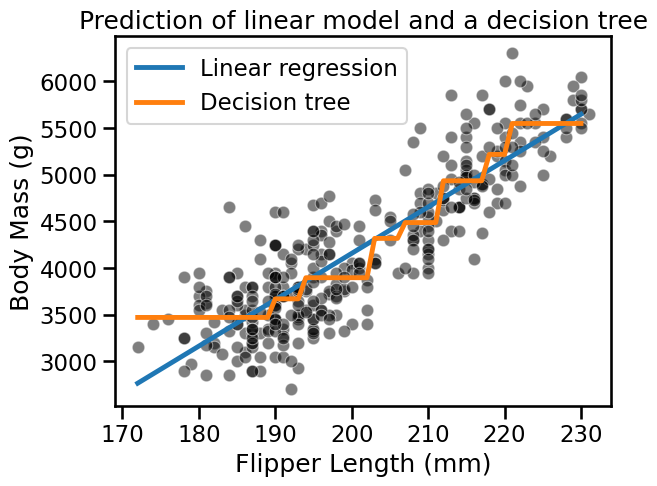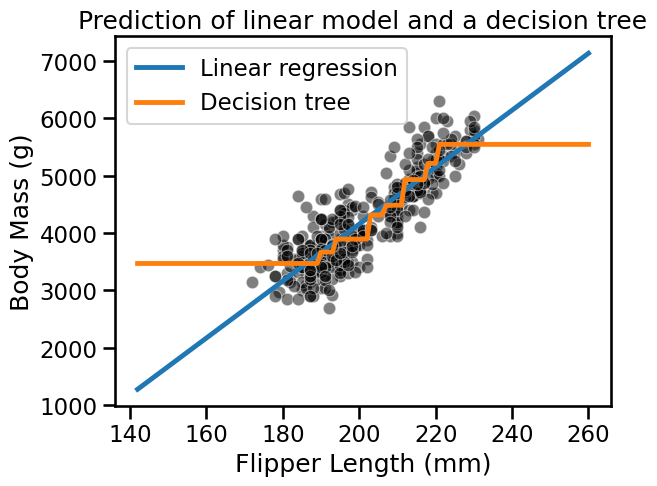📃 Solution for Exercise M5.02#
The aim of this exercise is to find out whether a decision tree model is able to extrapolate.
By extrapolation, we refer to values predicted by a model outside of the range of feature values seen during the training.
We first load the regression data.
import pandas as pd
penguins = pd.read_csv("../datasets/penguins_regression.csv")
feature_name = "Flipper Length (mm)"
target_name = "Body Mass (g)"
data_train, target_train = penguins[[feature_name]], penguins[target_name]
Note
If you want a deeper overview regarding this dataset, you can refer to the Appendix - Datasets description section at the end of this MOOC.
First, create two models, a linear regression model and a decision tree regression model, and fit them on the training data. Limit the depth at 3 levels for the decision tree.
# solution
from sklearn.linear_model import LinearRegression
from sklearn.tree import DecisionTreeRegressor
linear_regression = LinearRegression()
tree = DecisionTreeRegressor(max_depth=3)
linear_regression.fit(data_train, target_train)
tree.fit(data_train, target_train)
DecisionTreeRegressor(max_depth=3)In a Jupyter environment, please rerun this cell to show the HTML representation or trust the notebook.
On GitHub, the HTML representation is unable to render, please try loading this page with nbviewer.org.
DecisionTreeRegressor(max_depth=3)
Create a synthetic dataset containing all possible flipper length from the minimum to the maximum of the training dataset. Get the predictions of each model using this dataset.
# solution
import numpy as np
data_test = pd.DataFrame(
np.arange(data_train[feature_name].min(), data_train[feature_name].max()),
columns=[feature_name],
)
target_predicted_linear_regression = linear_regression.predict(data_test)
target_predicted_tree = tree.predict(data_test)
Create a scatter plot containing the training samples and superimpose the predictions of both models on the top.
# solution
import matplotlib.pyplot as plt
import seaborn as sns
sns.scatterplot(
data=penguins, x=feature_name, y=target_name, color="black", alpha=0.5
)
plt.plot(
data_test[feature_name],
target_predicted_linear_regression,
label="Linear regression",
)
plt.plot(data_test[feature_name], target_predicted_tree, label="Decision tree")
plt.legend()
_ = plt.title("Prediction of linear model and a decision tree")

The predictions that we got were within the range of feature values seen during training. In some sense, we observe the capabilities of our model to interpolate.
Now, we check the extrapolation capabilities of each model. Create a dataset containing a broader range of values than your previous dataset, in other words, add values below and above the minimum and the maximum of the flipper length seen during training.
# solution
offset = 30
data_test = pd.DataFrame(
np.arange(
data_train[feature_name].min() - offset,
data_train[feature_name].max() + offset,
),
columns=[feature_name],
)
Finally, make predictions with both models on this new interval of data. Repeat the plotting of the previous exercise.
# solution
target_predicted_linear_regression = linear_regression.predict(data_test)
target_predicted_tree = tree.predict(data_test)
sns.scatterplot(
data=penguins, x=feature_name, y=target_name, color="black", alpha=0.5
)
plt.plot(
data_test[feature_name],
target_predicted_linear_regression,
label="Linear regression",
)
plt.plot(data_test[feature_name], target_predicted_tree, label="Decision tree")
plt.legend()
_ = plt.title("Prediction of linear model and a decision tree")

The linear model extrapolates using the fitted model for flipper lengths < 175 mm and > 235 mm. In fact, we are using the model parametrization to make these predictions.
As mentioned, decision trees are non-parametric models and we observe that they cannot extrapolate. For flipper lengths below the minimum, the mass of the penguin in the training data with the shortest flipper length will always be predicted. Similarly, for flipper lengths above the maximum, the mass of the penguin in the training data with the longest flipper will always be predicted.

